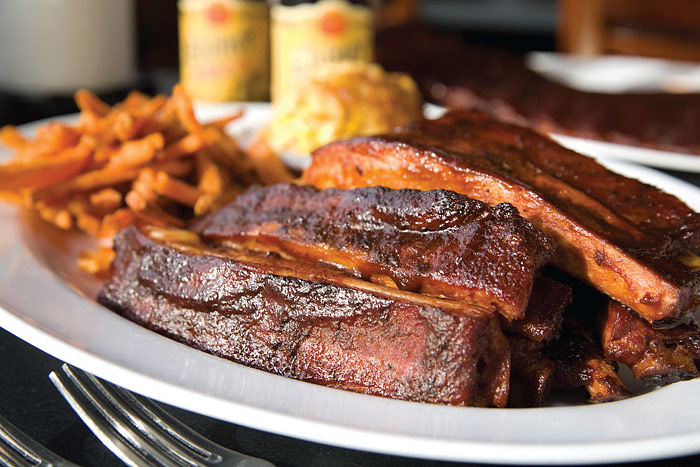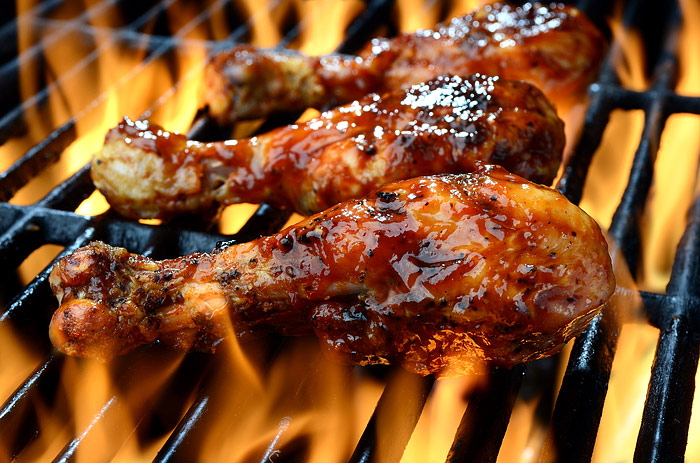
Barbecue is personal. Ask anyone what makes for good ’cue and the answer varies, probably based on where they’re from. To understand barbecue styles is to understand what barbecue is. Barbecue is a method of cooking meat, traditionally tough, less expensive cuts, in a wood-burning pit over a low temperature for a long period of time to create tender, moist, flavorful results.
Regional flavors are based on the type of seasoning used. The seasoning may date back to the first settlers in the area. For example, Germans settled in South Carolina and brought a strong mustard-based influence to barbecue.
Here is a historical breakdown of barbecue styles by region: the history of each regional flavor, its differences, and restaurants that serve it. Who knew barbecue was so diverse?
Kansas City
Kansas-City-style barbecue includes a wide variety of meats, and is perhaps the most popular style in the U.S. Kansas-City-style sauce, a tangy and sweet, tomato-and-molasses-based sauce, is what many think of when they think of barbecue sauce. Memphis native Henry Perry, known as “The Father of Kansas City Barbecue” opened up the first commercial barbecue restaurant in 1907. His disciple Arthur Bryant opened up shop in 1930. Today, Arthur Bryant’s is one of the most famous barbecue restaurants in the country.
Kansas City is home to the American Royal, known as the World Series of barbecue. The Kansas City Barbecue Society (KCBS) has over 15,000 members and is the largest sanctioning body of barbecue competitions, at more than 400 per year. KCBS contestants enter four main categories: chicken, ribs, pork, and brisket, judged on taste, appearance, and texture.
Signature Style: Tangy, Sweet; Tomato-and-Molasses-Based Sauce
Meat Specialties: Burnt Ends from a Beef Brisket
Where to Taste: Arthur Bryant’s in Kansas City, MO
Memphis
Memphis-style barbecue is primarily pork, notably ribs, often served dry versus the wet western style of other regions. “Dry” means chefs use only a dry rub for flavoring, while wet style uses a sauce applied during the entire cooking process. A “mop” sauce is often mopped on during the cooking process to keep the meat moist. Traditional Memphis-style dry rub consists of salt, pepper, paprika, cayenne, sugar, and a variety of other spices. Many restaurants serve their ribs dry with sauce on the table for those who want it.
Memphis is home to the legendary Memphis in May or “Superbowl of Swine:” the largest pork barbecue competition in the world. Notable restaurants include Charlie Vergo’s Rendezvous (named to the list of top five best ribs and mail-order meat by Esquire), Interstate, Neely’s, Corky’s (known for their presence in national grocery stores and mail-order service), and Memphis Barbecue Company.
Signature Style: Salt, Pepper, Paprika, Cayenne, and Sugar Dry Rub
Meat Specialties: Pork Ribs
Where to Taste: Charlie Vergo’s Rendezvous in Memphis, TN
Texas
Texas-style barbecue is all about the beef, especially the brisket. Texas has four distinct styles of barbecue: East Texas, Central Texas, West Texas, and South Texas. The emphasis in Texas falls on the meat, not the sauce. Texas-style sauce is usually thin and tomato-based, mixed with beef drippings, chili pepper, and spices.

The Germans and Czechs brought meat-market-style barbecue to the central part of the state; it originated in the butcher shops and can be found at places such as Mueller’s or Kreuz Market near Lockhart. “Hot Guts” is the old-school terminology for the German-inspired local sausage of the nearby Elgin area, known as the sausage capital of Texas. Every spring, the Houston Livestock Show and Rodeo hosts the World’s Championship Bar-B-Que Contest. The contest is one of the largest in the state and typically hosts over 300 teams. Austin is home to Franklin Barbecue, named by Bon Appétit as the best barbecue restaurant in the country.
Signature Style: Thin, Tomato-Based Sauce with Beef Drippings, Chili Pepper, Spice
Meat Specialties: Beef Brisket
Where to Taste: Franklin Barbecue in Austin, TX
North-Carolina
North-Carolina-style barbecue has two distinct styles: Piedmont (also referred to as Lexington style) and Eastern style.
Lexington, North Carolina, refers to itself as The Barbecue Capital of the World. Lexington style uses pork shoulder; the sauce is a vinegar-and-tomato-based red sauce that is often used in place of mayo as the base for coleslaw. Go to Lexington Barbecue Restaurant for authentic Lexington-style ’cue; don’t forget to order a Cheer Wine, the state’s local cherry-flavored soda, to go with your sandwich.
Eastern style, found in the eastern and coastal parts of the state, focuses on the whole hog; the sauce is only vinegar and pepper, which is often used as a mop sauce during cooking.
There is much debate within the state as to which style of barbecue is most popular. North Carolinians show off their barbecue chops at the Lexington Barbecue Festival, which was named the Official Food Festival of the Piedmont Triad Region of the State of North Carolina.
Signature Style: Vinegar-and-Tomato-Based Red Sauce, and Vinegar-and-Pepper Sauce
Meat Specialties: Pork (Whole Hog)
Where to Taste: Lexington Barbecue in Lexington, NC
South-Carolina
South-Carolina-style barbecue can be divided into three different styles, one of which is the only one that uses a mustard-based sauce. The state’s western section features a peppery, tomato-based sauce. The central area focuses on a German influence with that notable mustard sauce, referred to as Carolina Gold. The third style hails from the coastal Pee Dee region and uses a thin, spicy, vinegary, peppery sauce.

The South Carolina Barbecue Association holds more than 10 different barbecue competitions through out the year. Based on their competition results, the association names an overall state champion each year.
Signature Style: Mustard-Based Sauce
Meat Specialties: Pork (The Whole Hog)
Where to Taste: Scott’s Bar-B-Que in Hemingway, SC
Kentucky
Kentucky-style barbecue has two separate barbecue regions: the western region and south-central region.
The western part of the state, home to the most popular style, is known for its mutton-based barbecue, which comes from the wool production that began in the 1800s. The mutton from a mature sheep is typically served with a vinegar-based sauce called mutton dip. This popular combination can be found at the Old Hickory Restaurant in Owensboro. Owensboro hosts the International Bar-B-Q Festival, which features a Mutton Glutton party, followed by a 5k that helps burn off some of those calories.
The south-central part of Kentucky is known for its use of thin-sliced pork shoulder dressed with a pepper-and-vinegar sauce.
Signature Style: Mutton Dip, a Vinegar-Based Sauce
Meat Specialties: Mutton, Mature Sheep
Where to Taste: Old Hickory in Owensboro, KY
Alabama
Alabama-style barbecue is all about the pork. You will find smoked pork shoulder, butt, or ribs. Various parts of Alabama embrace bordering regions, including the styles of nearby Tennessee and the Carolinas. Their influence can be seen in the sauces: one sauce is distinctively Alabama and called Alabama White Sauce. This characteristic mayonnaise-based barbecue sauce also includes cider vinegar, lemon juice, horseradish, salt, pepper, and hot sauce.

Big Bob Gibson’s of Decatur, Alabama, lays claim to the creation of Alabama White Sauce, which was originally used for “baptizing” chickens; however, it is now used as a sauce for pork as well.
Alabama’s finest barbecue chefs compete each year for the Alabama Governor’s Cup, which is presented to the barbecue teams who complete the Alabama Barbecue Trail with the most points.
Signature Style: White Sauce (Mayonnaise-Based, With Cider Vinegar, Lemon Juice, Horseradish, Salt, Pepper, and Hot Sauce)
Meat Specialties: Pork (Shoulder, Butt, Ribs)
Where to Taste: “Big Bob” Gibson Bar-B-Q of Decatur, AL





Leave a Reply